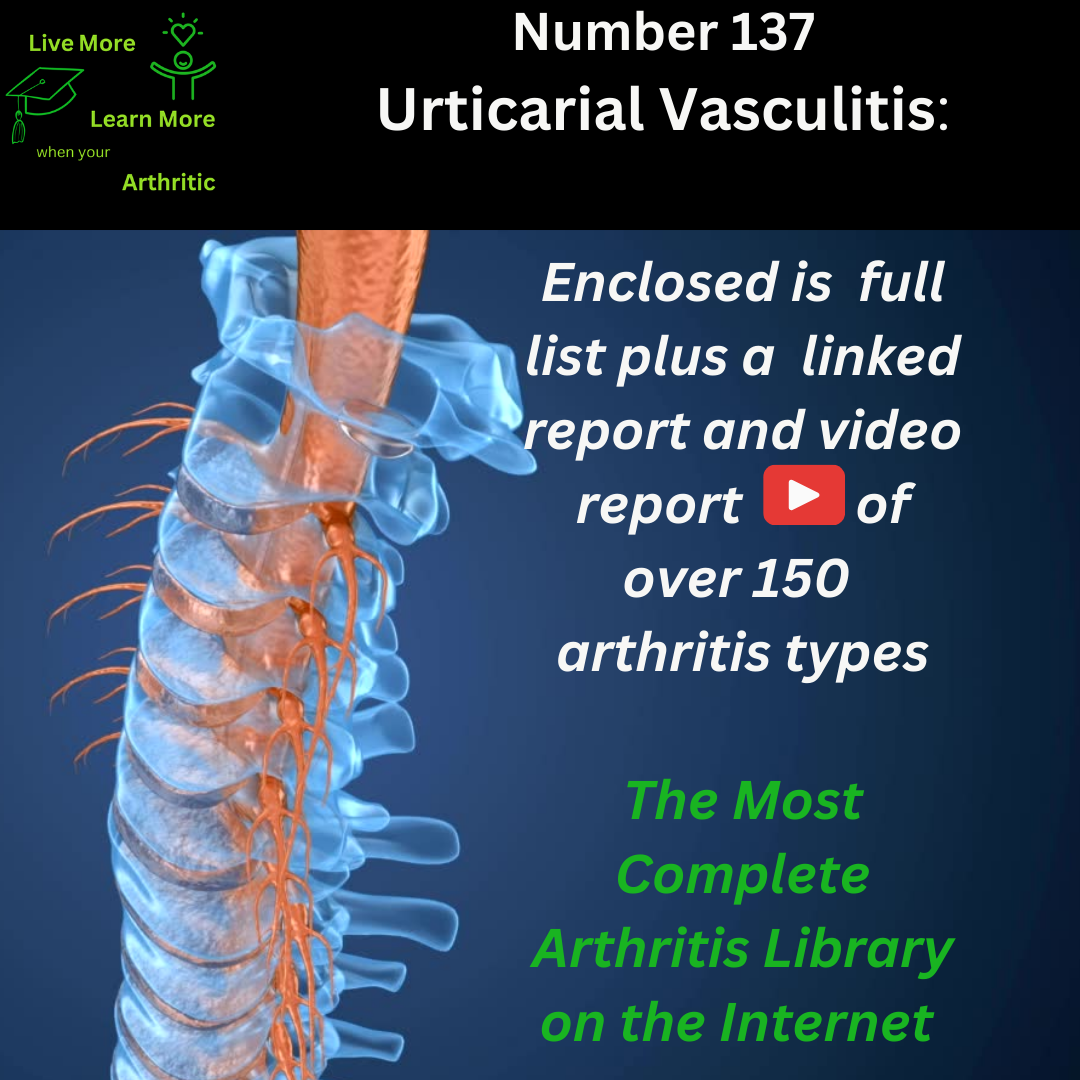
Urticarial Vasculitis: Number 136 of around 150 types of Arthritis
 Understanding Urticarial Vasculitis: A Journey through the Body’s Response
Understanding Urticarial Vasculitis: A Journey through the Body’s Response
Urticarial vasculitis, an uncommon condition, can affect various parts of the body, particularly the skin and joints. Among the joints, the most commonly affected areas include the knees, ankles, wrists, and elbows. This inflammatory response can lead to symptoms like joint pain, swelling, and limited range of motion.
Nature of Remission and Disease Description
Remission in urticarial vasculitis is possible, but it can vary greatly from person to person. Achieving remission often requires careful management and monitoring of triggers and symptoms. This disease is characterized by inflammation of the small blood vessels in the skin, resulting in hives that are painful and longer-lasting than typical urticaria.
Causes, Triggers, and Age of Onset
The exact cause of urticarial vasculitis is not always clear, but it’s believed to be linked to autoimmune factors where the immune system mistakenly attacks blood vessels. Common triggers include infections, medications, exposure to cold, and autoimmune diseases. The onset of this condition can occur at any age, but it’s often seen in adults between 30 to 50 years old.
Impact on Lifespan and Autoimmune Connection
Urticarial vasculitis is considered an autoimmune form of arthritis. While it can significantly impact one’s quality of life due to joint pain and other symptoms, it doesn’t necessarily shorten lifespan. However, complications related to the disease can affect overall health and well-being.
Risk Factors and Complications
Risk factors for urticarial vasculitis include a history of autoimmune diseases, certain infections, and exposure to environmental triggers. Complications can vary but often include chronic joint pain, organ involvement (like kidneys), and increased susceptibility to infections due to immune system dysfunction.
Understanding Inflammation and Joint Tenderness
Inflammation and joint tenderness are key factors in urticarial vasculitis. Inflammation occurs due to the immune system attacking blood vessels, leading to localized swelling and pain. Joint tenderness results from inflammation affecting the surrounding tissues and nerves.
Impact on Range of Motion and Cartilage
Limited range of motion in urticarial vasculitis can occur due to joint swelling and pain. Cartilage, the smooth tissue that covers the ends of bones where they meet to form joints, may also be affected by ongoing inflammation, potentially leading to further joint damage and stiffness over time.
Lifestyle and Proactive Management
Although there is no specific medication for urticarial vasculitis mentioned, proactive management is crucial to improve quality of life. This includes identifying and avoiding triggers, maintaining a healthy lifestyle, managing stress, and seeking appropriate medical care.
Complications and Common Age of Onset
Possible complications of urticarial vasculitis include chronic pain, skin damage, kidney problems, and increased risk of infections. The condition can affect individuals of various ages but is most commonly seen in adults, particularly those between 30 to 50 years old. There is no significant gender predilection, although some studies suggest it may be slightly more common in women.
 Interconnected Diseases and Conditions
Interconnected Diseases and Conditions
Urticarial vasculitis is often associated with other autoimmune conditions such as systemic lupus erythematosus (SLE) and Sjögren’s syndrome. This interconnectedness underscores the complex nature of autoimmune diseases and the importance of comprehensive medical evaluation and management when diagnosed with urticarial vasculitis.
In summary, while urticarial vasculitis poses challenges due to its impact on joints and skin, a proactive approach involving lifestyle modifications and close medical supervision can enhance quality of life and minimize complications associated with this autoimmune condition. Understanding the nature of the disease, its triggers, and potential complications is essential for effective management and well-being.
